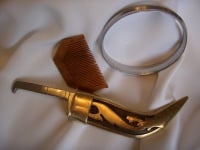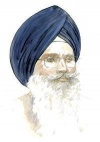Five ks: Difference between revisions
Hari singh (talk | contribs) No edit summary |
No edit summary |
||
| Line 2: | Line 2: | ||
[[Image:CIMG0349.JPG|thumb|200px|left|Kanga, Kara and Kirpan - three of the five articles of faith endowed to the Sikhs by Guru Gobind Singh]] | [[Image:CIMG0349.JPG|thumb|200px|left|Kanga, Kara and Kirpan - three of the five articles of faith endowed to the Sikhs by Guru Gobind Singh]] | ||
Sikhs wear an external uniform to unify and bind them to the beliefs of the religion and to remind them of their commitment to the Sikh Gurus at all times. Unlike some other faiths where only the clergy are in uniform, all Sikhs are enjoined to wear the uniform of their beliefs. These five articles of faith distinguish a Sikh and are essential for preserving the life of the community. | |||
''' | The '''Five Ks''', or ''panj kakaar/kakke'', are five items of faith that initiated [[Khalsa]] [[Sikh]]s wear at all times at the command of the tenth Sikh [[Guru]], [[Guru Gobind Singh]] who so ordered at the [[Baisakhi]] [[Amrit Sanchar]] in [[1699]]. The Five Ks are not merely symbols but articles of faith which collectively form the external visible symbols to identify and clearly and outwardly advertise and display ones commitment and dedication to the order ([[Hukam]]) of the tenth master. Guru Gobind Singh ordered his followers to wear the Five Ks so that they could actively use them to make a difference to their own and to others' spirituality. | ||
[[ | =='''The Five K's'''== | ||
[[Keski]] (short turban) relates to the element of ether | |||
[[Kanga]] (wooden comb) relates to the element of earth | [[Kanga]] (wooden comb) relates to the element of earth | ||
| Line 14: | Line 15: | ||
[[Kara]] (steel bracelet) relates to the element of air | [[Kara]] (steel bracelet) relates to the element of air | ||
[[ | [[Kachhera]] (cotton underwear) relates to the element of water | ||
[[Kirpan]] (sword) which relates to the element of fire. | [[Kirpan]] (sword) which relates to the element of fire. | ||
==Keski== | |||
[[Image:Turban sikh.jpg|100px|left|Keski/Dastaar - The turban is one of the five articles of faith for the Sikhs]] | |||
The [[Keski]]/ [[Dastaar]] is worn to protect the Kesh (unshorn hair) and guard the Dasam Duaar (the Tenth Gate), a spiritual opening at the top of the head. The turban is a spiritual crown, which is a constant reminder to the Sikh that he or she is sitting on the throne of consciousness and is committed to living to principles. It is the identity of a Sikh. Guru Gobind Singh jee told His Sikhs: “Khaalsa mero roop hai kaas. Khaalsa mai ho karo nivaas... The Khalsa is my image. Within the Khalsa I reside.” Wearing a turban declares sovereignty, dedication, self-respect, courage and piety. | |||
[[ | |||
==Kanga== | ==Kanga== | ||
[[Image:CIMG0336.JPG|100px|right|Kanga - one of the five articles of faith for the Sikhs]] | [[Image:CIMG0336.JPG|100px|right|Kanga - one of the five articles of faith for the Sikhs]] | ||
The [[Kanga]] is kept in the hair knot and is used to keep hygiene and look after the Kesh (unshorn hair). Combing the hair twice a day, dead hair is removed and one keeps tidy. | |||
{{Main|Kanga}} | {{Main|Kanga}} | ||
| Line 42: | Line 40: | ||
{{Main | Kara}} | {{Main | Kara}} | ||
== | ==Kacchera== | ||
[[Image:CIMG0334.JPG|100px|right|Kaccha - one of the five articles of faith for the Sikhs]] | [[Image:CIMG0334.JPG|100px|right|Kaccha - one of the five articles of faith for the Sikhs]] | ||
A | A [[Kacchera]] is a pair of knee length shorts. Practically it covers our body and ensures a Sikh is always ready and dressed modestly. Thus it is quite useful in hot weather, swimming and sports activities. The Kachhera reminds the Sikh to uphold high moral character and to control his or her desires. | ||
{{Main|Kaccha}} | {{Main|Kaccha}} | ||
| Line 52: | Line 50: | ||
[[Image:CIMG0308.JPG|100px|left|Typical Kirpan worn by modern Sikhs]] | [[Image:CIMG0308.JPG|100px|left|Typical Kirpan worn by modern Sikhs]] | ||
[[Kirpan]] comes from the word 'KIRPA' and 'AAN'. Kirpa means an act of kindness or a favour; 'aan' means honour, respect, and self-respect. It is an instrument which adds to self-respect and self-defence. Thus for Sikhs, Kirpan is the symbol of power and freedom of spirit. All | The [[Kirpan]] represents ‘Truth & Justice’. The Kirpan reminds a Sikh of his or her duty to stand up for justice, to protect the weak and not to falter in his or her duty. The Kirpan is a Shastar, (close-combat) protective weapon, to be used in the last resort to defend oneself, to defend Faith, and to protect the weak. | ||
Kirpan comes from the word 'KIRPA' and 'AAN'. Kirpa means an act of kindness or a favour; 'aan' means honour, respect, and self-respect. It is an instrument which adds to self-respect and self-defence. Thus for Sikhs, Kirpan is the symbol of power and freedom of spirit. All initiated Sikhs should wear a short form of Kirpan (approx. 6" to 9" long) on their body. To call it a dagger or knife is rather insulting to this article of faith, which functions quite differently from the other two. The blade should be made of iron. | |||
A Sikh should never use the Kirpan in anger or for a malicious attack. However, a Sikh may use it in self-defence or to protect a person in need. Some Sikhs choose to learn the art of [[Gatka]]. This is a martial art devised by the Sikh Gurus that uses circular movements to effectively swing a sword. | A Sikh should never use the Kirpan in anger or for a malicious attack. However, a Sikh may use it in self-defence or to protect a person in need. Some Sikhs choose to learn the art of [[Gatka]]. This is a martial art devised by the Sikh Gurus that uses circular movements to effectively swing a sword. | ||
{{Main |Kirpan}} | {{Main |Kirpan}} | ||
=='''The Spiritual Signifance of the 5K's'''== | |||
'''Desires/ Lust (Kaam)''' | |||
Wearing the Kachherĝ, a Sikh is reminded to control his desire and only look at his own wife or husband. The Kachherĝ reminds us to self-control and to control the urges of Kaam. | |||
'''Greed (Lobh)''' | |||
Wearing the Karĝ in our hand we are reminded not to commit crime or theft with our hands. The Karĝ constantly reminds us of Guru Ji and the hands which can be used to misdeeds fuelled by greed are reminded "you are bound to the Guru, remember Vaheguru is always watching you". Therefore, the Kara is a continual reminder of “Think of the Guru, before yourself”. | |||
'''Anger (Krodh)''' | |||
Wearing the Kirpaan, you have the power to kill someone and therefore you to have control your anger more than the other person. The Kirpan represents the Grace, Truth and Justice, which a Sikh represents which can only happen if a Sikh has no anger. | |||
'''Attachment (Moh)''' | |||
Combing the hair twice a day, when one sees the dead hair being combed out, one is reminded that just as our hair are not permanent, so is everything around us. One should comb one's mind with Gurbaani (the Divine Word), just as one comb's their hair with a comb. | |||
'''Ego (Haumai)''' | |||
Maintaining Kesh covered with a Dastaar (turban) on the head one commits him or herself to higher consciousness, saving them from vanity. Crowning oneself with a Dastaar one is reminded that their head belongs to Guru Sahib and that they should not have ego. With a turban covering the hair-knot on top of Dasam Duaar (a spiritual opening on the top of the head), all worldly fashion stops dead. The Dastaar guards the Sikh man and woman from drowning in vanity and society-led fashions. A man or woman wearing a turban well be self-conscious of living up to their principles, living up to the image they are portraying and the Guru they are representing, therefore subduing their ego and Manmukh (self-centred) mind. | |||
==See also== | ==See also== | ||
| Line 62: | Line 91: | ||
* [[Vaisakhi]] | * [[Vaisakhi]] | ||
{{5Ks}} | {{5Ks}} | ||
Revision as of 14:48, 14 October 2006
| Part of a series on Sikh Practices |
| Sikhism |
| Sanskar |
| Sikh rites |
| Personal 5 Banis . Five ks |
Sikhs wear an external uniform to unify and bind them to the beliefs of the religion and to remind them of their commitment to the Sikh Gurus at all times. Unlike some other faiths where only the clergy are in uniform, all Sikhs are enjoined to wear the uniform of their beliefs. These five articles of faith distinguish a Sikh and are essential for preserving the life of the community.
The Five Ks, or panj kakaar/kakke, are five items of faith that initiated Khalsa Sikhs wear at all times at the command of the tenth Sikh Guru, Guru Gobind Singh who so ordered at the Baisakhi Amrit Sanchar in 1699. The Five Ks are not merely symbols but articles of faith which collectively form the external visible symbols to identify and clearly and outwardly advertise and display ones commitment and dedication to the order (Hukam) of the tenth master. Guru Gobind Singh ordered his followers to wear the Five Ks so that they could actively use them to make a difference to their own and to others' spirituality.
The Five K's
Keski (short turban) relates to the element of ether
Kanga (wooden comb) relates to the element of earth
Kara (steel bracelet) relates to the element of air
Kachhera (cotton underwear) relates to the element of water
Kirpan (sword) which relates to the element of fire.
Keski
The Keski/ Dastaar is worn to protect the Kesh (unshorn hair) and guard the Dasam Duaar (the Tenth Gate), a spiritual opening at the top of the head. The turban is a spiritual crown, which is a constant reminder to the Sikh that he or she is sitting on the throne of consciousness and is committed to living to principles. It is the identity of a Sikh. Guru Gobind Singh jee told His Sikhs: “Khaalsa mero roop hai kaas. Khaalsa mai ho karo nivaas... The Khalsa is my image. Within the Khalsa I reside.” Wearing a turban declares sovereignty, dedication, self-respect, courage and piety.
Kanga
The Kanga is kept in the hair knot and is used to keep hygiene and look after the Kesh (unshorn hair). Combing the hair twice a day, dead hair is removed and one keeps tidy.
- Main article: Kanga
Kara
Kara means a link. It is a special iron bracelet which is worn on the wrist of the dominant hand. The Kara is the Guru's own symbolic ring to all his Sikhs signifying their unbreakable link with the Guru as well as among themselves. The circle is also a symbol of controlling feelings and practice as well as a constant reminder to the Sikh of complete behavior in the event of weakness.
- Main article: Kara
Kacchera
A Kacchera is a pair of knee length shorts. Practically it covers our body and ensures a Sikh is always ready and dressed modestly. Thus it is quite useful in hot weather, swimming and sports activities. The Kachhera reminds the Sikh to uphold high moral character and to control his or her desires.
- Main article: Kaccha
Kirpan
The Kirpan represents ‘Truth & Justice’. The Kirpan reminds a Sikh of his or her duty to stand up for justice, to protect the weak and not to falter in his or her duty. The Kirpan is a Shastar, (close-combat) protective weapon, to be used in the last resort to defend oneself, to defend Faith, and to protect the weak.
Kirpan comes from the word 'KIRPA' and 'AAN'. Kirpa means an act of kindness or a favour; 'aan' means honour, respect, and self-respect. It is an instrument which adds to self-respect and self-defence. Thus for Sikhs, Kirpan is the symbol of power and freedom of spirit. All initiated Sikhs should wear a short form of Kirpan (approx. 6" to 9" long) on their body. To call it a dagger or knife is rather insulting to this article of faith, which functions quite differently from the other two. The blade should be made of iron.
A Sikh should never use the Kirpan in anger or for a malicious attack. However, a Sikh may use it in self-defence or to protect a person in need. Some Sikhs choose to learn the art of Gatka. This is a martial art devised by the Sikh Gurus that uses circular movements to effectively swing a sword.
- Main article: Kirpan
The Spiritual Signifance of the 5K's
Desires/ Lust (Kaam)
Wearing the Kachherĝ, a Sikh is reminded to control his desire and only look at his own wife or husband. The Kachherĝ reminds us to self-control and to control the urges of Kaam.
Greed (Lobh)
Wearing the Karĝ in our hand we are reminded not to commit crime or theft with our hands. The Karĝ constantly reminds us of Guru Ji and the hands which can be used to misdeeds fuelled by greed are reminded "you are bound to the Guru, remember Vaheguru is always watching you". Therefore, the Kara is a continual reminder of “Think of the Guru, before yourself”.
Anger (Krodh)
Wearing the Kirpaan, you have the power to kill someone and therefore you to have control your anger more than the other person. The Kirpan represents the Grace, Truth and Justice, which a Sikh represents which can only happen if a Sikh has no anger.
Attachment (Moh)
Combing the hair twice a day, when one sees the dead hair being combed out, one is reminded that just as our hair are not permanent, so is everything around us. One should comb one's mind with Gurbaani (the Divine Word), just as one comb's their hair with a comb.
Ego (Haumai)
Maintaining Kesh covered with a Dastaar (turban) on the head one commits him or herself to higher consciousness, saving them from vanity. Crowning oneself with a Dastaar one is reminded that their head belongs to Guru Sahib and that they should not have ego. With a turban covering the hair-knot on top of Dasam Duaar (a spiritual opening on the top of the head), all worldly fashion stops dead. The Dastaar guards the Sikh man and woman from drowning in vanity and society-led fashions. A man or woman wearing a turban well be self-conscious of living up to their principles, living up to the image they are portraying and the Guru they are representing, therefore subduing their ego and Manmukh (self-centred) mind.
See also
- The Amrit Sanskar ceremony
- Vaisakhi
| These articles deal with Sikh's Five ks |
|
Kesh (uncut hair) -|- Kara (bangle) -|- Kanga (small comb) -|- Kachera (under garment) -|- Kirpan (sword) |
| Gurus: | Nanak Dev | Guru Angad | Amar Das | Ram Das | Guru Arjan | Har Gobind | Har Rai | Har Krishan | Tegh Bahadur | Gobind Singh | Guru Granth Sahib | Sikh Bhagats |
| Philosophy: | Sikh Beliefs | Simran | Sewa | Beliefs and Principles | Underlying Values | Prohibitions | Technique and Methods | Other observations | Technique and Methods |
| Practices: | Ardas | Amrit Sanskar | Chardi Kala | Dasvandh | Five Ks | Kirat Karni | Kirtan | Langar | Naam Japna | Simran | Three Pillars | Vand Chakna | Five Evils | Five Virtues |
| Scripture: | Guru Granth Sahib | Sikh Scripture | Dasam Granth | Ek Onkar | Waheguru | Bani | Mool Mantar | Japji Sahib | Jaap Sahib | Chaupai | Anand Sahib | Tav-Prasad Savaiye | Rehras | Sukhmani |
| More: | History | Gurdwaras | Harmandir Sahib | Khalsa | Khanda | Names | Places | News | Satguru | Sikhs | Bhagat Farid | Bhagat Kabir | Websites | Biographical | Terms |







